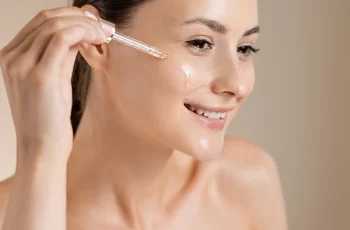
Salicylic Acid or Niacinamide for Blackheads?
Now if this isn’t your first rodeo and you have a slight understanding of skincare, you may wonder how two skincare ingredients that deliver such different results can be used to target blackheads. Well, this is the focus for us today, so if you’re wanting to know whether to use salicylic acid or niacinamide for blackheads stick around to find out more.
What is Niacinamide?
Niacinamide is a form of vitamin B3 which can be found in an array of vitamin rich foods, such as kale, green vegetables, and almonds. It plays an important role at maintaining a healthy skin with its impressive multi-tasking. Some of the benefits of niacinamide on the skin are its ability to hydrate, keep the skin protected from outer aggressors and lock moisture into the lower layers of the skin. You’ll find that signs of ageing, such as fine lines and wrinkles are significantly reduced, and the skin’s tone and texture have both improved dramatically. One final bonus of niacinamide is the fact it can regulate the sebum production of the skin helping oily and blemish prone skin types remain balanced, hydrated, and healthy.
What is Salicylic Acid?
One of the most used Beta Hydroxy Acids (BHA) salicylic acid has gained a reputation for targeting acne prone skin as well as other blemishes and breakouts. As a chemical exfoliant it can slough away the build-up of dead skin cells and debris that sit on the surface of the face. The unique benefit of salicylic acid is the fact it is oil soluble meaning it can cut through oil and penetrate deep into the pores and clear them out of bacteria, dirt, and excess sebum.
Compared to niacinamide, salicylic acid isn’t as multi-tasking instead its focus is helping to exfoliate the skin and reaching areas of the skin that are untouched by other chemical exfoliants such as the popular Alpha Hydroxy Acids, glycolic acid, and lactic acid. This BHA is highly potent and does require you to ensure you introduce it into your daily routine correctly. This is advised to avoid any unwanted side effects such as severe dryness, irritation, and redness. Those with a dry and sensitive skin type should consult with a doctor or dermatologist before using salicylic acid on the face, as for those who are more prone to oiliness remember to not overuse any product enriched in this acid as this can cause skin dryness and strip the outer layers of oil.
Does niacinamide help with blackheads?
Yes, niacinamide helps with blackheads, but it would not be able to get rid of blackheads single handily. It can do this by preventing blackheads from developing thanks to its ability to reduce inflammation, regulate sebum production and minimise the appearance of pores. All of this whilst ensuring the skin barrier remains fully functioning with the correct levels of water and oil. This is important for your skin health and overall appearance of the complexion as this results in any signs of damage are reduced with protection from further damage.
Which is better salicylic acid or niacinamide?
This is one of the trickiest questions to answer when it comes to these two powerhouse ingredients. The truth is one isn’t better than the other as they provide their own unique benefits for the skin. Salicylic acid is highly effective at clearing the complexion ridding it of the dead skin cell barrier preventing the active ingredients in other skincare formulations to absorb into the skin. The difference with niacinamide is that it can boost hydration for the face whilst working at reducing any imbalance to the protective barrier which is found on the outer surface.
Does niacinamide help with whiteheads?
As I have already mentioned, niacinamide contains anti-inflammatory properties which basically means it will target any area of inflammation preventing any pimples from forming into active spots and breakouts. Although niacinamide is unable to rid the skin of developed whiteheads, it is able to reduce their frequency resulting overtime to fewer blemishes and whiteheads.
Can I use niacinamide and salicylic acid together?
Absolutely! Both ingredients when teamed together make an impressive skin duo, especially for those with an oily and acne-prone skin type. Quite often we have discovered those who find their skin be oily tend to overuse products enriched in salicylic acid in the hopes they will cleanse their skin. The problem you face is that once you have cleansed the skin it is important to replenish it with hydration, this is when niacinamide can step in and lock moisture into the skin. By teaming these together, you will find the complexion is left reaping the rewards of salicylic acid ridding it of any impurity build-up whilst any signs of dryness are counteracted with the help from niacinamide and its hydration boost.
Can salicylic acid remove blackheads?
100%, in fact, removing blackheads is one of the main benefits salicylic acids can provide the skin. With the chemical exfoliating properties of the BHA results in any impurities, bacteria and surface debris are removed before they build-up and develop into blackheads and other blemishes. For existing blackheads, you will be able to rid the skin from them with the help of skincare products enriched with salicylic acid, such as exfoliating toners or serums.
With consistent application you can expect your complexion to gain more clarity, but word of warning, do not overuse salicylic acid, especially if you are new to the ingredient in your routine as this can lead to flare up in dryness, discomfort, and redness. If you have any concerns I suggest a consultation with a doctor, dermatologist or trained professional to find the best product for you and your skin.
Does niacinamide remove acne scars?
DQH Can I use salicylic acid first and then vitamin C?
It’s easy to create a skincare routine, but knowing how to use it is another thing entirely. In most cases, if you’re not getting the desired skin results, it could be due to the layering of conflicting ingredients. So, is it possible that salicylic acid and vitamin C are such ingredients? Or are these active ingredients the duo that’s been missing from your skincare routine? If you want answers, stick around because today we are going to explain the benefits of salicylic acid and vitamin C and how they can be used in your daily life.
What are the benefits of salicylic acid for skin?
Salicylic acid is one of the most commonly used beta hydroxy acids and is favored by many people with oily, acne-prone skin. This acid is derived from willow bark, and unlike its water-soluble relatives (called alpha-hydroxy acids), salicylic acid is oil-soluble, which means it can penetrate deeper into the lower layers of the skin. Once it reaches the lower layers, it can help unclog pores of excess sebum, dirt, bacteria, debris, and impurities. This results in clearer skin tones and greater definition.
Not only does salicylic acid benefit the underlying layers, but the outer surface of the skin benefits as well. When applied to the skin, salicylic acid removes the buildup of dead skin cells. This is accomplished by breaking the bonds that hold dead cells to the surface. Over time, this can cause the complexion to look dull and prone to acne, blackheads, and other blemishes.
If you’d like to learn more about salicylic acid and how it can improve your skin, check out this dedicated blog post from a beauty insider.
What are the benefits of vitamin C for skin?
Vitamin C is considered one of the most powerful antioxidants, which means it is very effective at fighting free radicals and preventing them from causing further skin damage. Examples of free radicals include pollution, central heating, UV rays and harsh climate. They attack proteins, fats and cell membranes as soon as they come into contact with the skin, causing signs of premature aging such as fine lines and wrinkles as well as hyperpigmentation, flaky patches of skin and loss of elasticity.
Many people usually prefer to use vitamin C in their morning routine as this ingredient gives the complexion a radiant glow. You’ll also find that vitamin C can target areas of hyperpigmentation, plumping the skin and reducing the appearance of fine lines and wrinkles.
The thing about vitamin C is that there are a lot of outdated studies going back to the 1950s that describe vitamin C as an unstable skin component. Thanks to improvements in modern technology, this is no longer the case as all products now contain a stable form of vitamin C.
Visit The Beauty Insider to learn more about vitamin C. So please check out our blog post.
Can I use salicylic acid first and then vitamin C?
Yes, you absolutely can. In fact, it’s thought that using salicylic acid before using vitamin C ensures it penetrates faster and works faster.
This is an efficient way to utilize two power sources, and the reason has to do with pH. For example, the skin’s natural pH is about 4.7, making it slightly acidic. Salicylic acid and vitamin C are also both acidic, and you’ll find that vitamin C is absorbed quickly into the skin. Therefore, using salicylic acid beforehand can increase the acidity of the skin and allow vitamin C to penetrate into the skin faster.
While this is considered an effective way to combine two powerful ingredients, you need to be aware of your skin type and how it reacts to certain active ingredients. Even people with perfect, normal skin can experience skin sensitivity and irritation. Therefore, always consult a doctor or dermatologist before using any new products on your skin.
It’s also important to follow skin application rules. In this case, you need to use the product correctly to ensure you get the best results for your skin. If you’re not sure what I mean, the basic rule for skin is to start with the thinnest consistency and work your way up to the thickest consistency. This prevents a barrier from forming on the surface, preventing other active ingredients from penetrating the skin.
Can I use salicylic acid at night and vitamin C in the morning?
Yes, absolutely, this is considered the most effective way to get returns without any adverse side effects. This is because there is enough time between applications to ensure that the skin’s pH levels return to balance.
You’ll also find that Vitamin C is rich in antioxidants and is perfect for use in the morning to ensure your skin is protected and looking its healthiest. Due to the small size of salicylic acid molecules, it is an acid that is able to reach the deepest parts of the skin. While this is effective at keeping skin clear, it also increases the risk of irritation and photosensitivity. Therefore, many people prefer to use powerful BHAs in their evening routine without exposure to UV rays, pollution, or harsh weather.
Warning: If you avoid using sunscreen every day, none of these ingredients will do what your skin needs. The combination of chemical peels and powerful ingredients increases the risk of further damage to the skin’s surface. Use SPF 50 every day to keep your skin protected and your lipid barrier healthy, even on cloudy days, keeping your skin in top condition.


